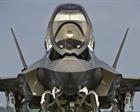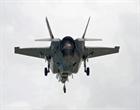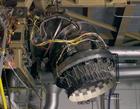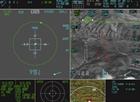F-35B update November 2014
The Ministry of Defence (MOD) has signed a contract (24 November 2014) for the first production batch of 4 Lightning II stealth combat aircraft – which will operate from both the Royal Navy’s new aircraft carriers and Royal Air Force (RAF) land bases.
The contract for the F-35B aircraft forms part of the MOD’s investment in Lightning II over the next 5 years to procure an initial 14 of these multi-role fifth generation aircraft, as well as putting in place the necessary support arrangements and infrastructure.
Vertical technology
A critical component of the F-35B short takeoff/vertical landing, STOVL, variant of the Lightning II is the three-bearing swivel duct nozzle, or 3BSD. The nozzle, mounted at the back of the aircraft, allows the thrust from the Pratt & Whitney F135 engine to be vectored from straight aft for conventional flight to straight down for STOVL operations. The 3BSD can move through ninety-five degrees of motion seamlessly with no change in engine operation. The nozzle also provides yaw control during hover and during transitions to hover.
A digital jet for the modern age
Underpinning the F-35’s unrivaled capabilities is more than 8 million lines of software. From flight controls to fusing together the F-35’s sensor data to form a clear and comprehensive picture of the battlespace, software is essential.
F-35 software enables: Flight controls; Radar functionality; Communications, navigation and identification; Electronic attack; Sensor fusion; Weapons deployment.
Short BBC video on F-35B simulator
The key to Initial Operating Capability
The Services have stated that software is the key to declaring Initial Operating Capability (IOC) for the F-35. Developing, integrating and testing more than 8 million lines of code on a supersonic stealth fighter is no small task.
From the program’s outset, the software team has focused on developing six key software releases known as Blocks:
Block 1A/1B – Block 1 comprises 76 percent of the more than 8 million source lines of code required for the F-35’s full warfighting capability. Block 1A was the ready for training configuration while Block 1B provided initial multi-level security.
Block 2A – Block 2A is currently released to the F-35 fleet. It provides enhanced training including functionality for off-board fusion, initial data links, electronic attack and mission debrief. Under Block 2A, nearly 86 percent of the required code for full warfighting capability is flying.
Block 2B – Block 2B provides initial warfighting capabilities, including but not limited to expanded data links, multi-ship fusion and initial live weapons. The U.S. Marines will declare IOC with Block 2B. Under Block 2B, more than 89 percent of the required code for full warfighting capability is flying.
Block 3i – Block 3i provides the same capabilities as Block 2B. The principal difference between 2B and 3i is the implementation of new hardware, specifically the updated Integrated Core Processor. The US Air Force will declare IOC with Block 3i. With Block 3i, more than 89 percent of code required for full warfighting capability will fly.
Block 3F – Block 3F provides 100 percent of the software required for full warfighting capability, including but not limited to data link imagery, full weapons and embedded training. Requirements development for Block 3F was completed in June of 2013.
Current Software Development Status
As of September 2014, more than 89 percent of the required F-35 software is currently flying. Approximately 98 percent of the required software has been coded. This equates to about 120,000 lines of code that remain to be written.
In 2013, the F-35 program flight tested the first four iterations of Block 2B, the software configuration the US Marines will use to declare Initial Operating Capability. Pilots conducted sensor fusion operations, executed night landings on the USS Wasp and dropped both air-to-air and air-to-ground ordnance. The software is proving to be stable and performing well.





